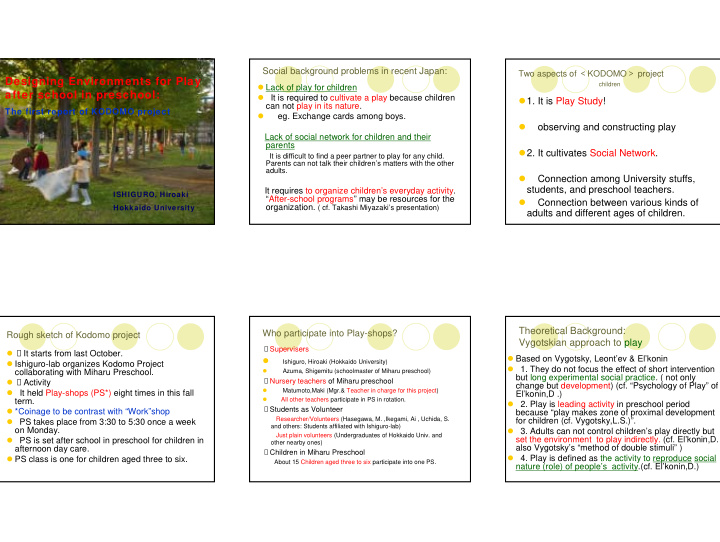



Social background problems in recent Japan: Two aspects of < KODOMO > project Designing Environments for Play � Lack of play for children children after school in preschool: � It is required to cultivate a play because children � 1. It is Play Study! can not play in its nature. The first report of KODOMO project � eg. Exchange cards among boys. � observing and constructing play Lack of social network for children and their parents � 2. It cultivates Social Network. It is difficult to find a peer partner to play for any child. Parents can not talk their children’s matters with the other adults. � Connection among University stuffs, students, and preschool teachers. It requires to organize children’s everyday activity. ISHIGURO, Hiroaki “After-school programs” may be resources for the � Connection between various kinds of organization. ( cf. Takashi Miyazaki’s presentation) Hokkaido University adults and different ages of children. Theoretical Background: Who participate into Play-shops? Rough sketch of Kodomo project Vygotskian approach to play ● Supervisers � ■ It starts from last October. � Based on Vygotsky, Leont’ev & El’konin � � Ishiguro-lab organizes Kodomo Project Ishiguro, Hiroaki (Hokkaido University) � 1. They do not focus the effect of short intervention � collaborating with Miharu Preschool. Azuma, Shigemitu (schoolmaster of Miharu preschool) but long experimental social practice. ( not only ● Nursery teachers of Miharu preschool � ■ Activity change but development) (cf. “Psychology of Play” of � � It held Play-shops (PS*) eight times in this fall Matumoto,Maki (Mgr.& Teacher in charge for this project) El’konin,D .) � All other teachers participate in PS in rotation. term. � 2. Play is leading activity in preschool period ● Students as Volunteer � *Coinage to be contrast with “Work”shop because “play makes zone of proximal development � PS takes place from 3:30 to 5:30 once a week Researcher/Volunteers (Hasegawa, M. ,Ikegami, Ai , Uchida, S. for children (cf. Vygotsky,L.S.)”. and others: Students affiliated with Ishiguro-lab) on Monday. � 3. Adults can not control children’s play directly but Just plain volunteers (Undergraduates of Hokkaido Univ. and � PS is set after school in preschool for children in set the environment to play indirectly. (cf. El’konin,D. other nearby ones) also Vygotsky’s “method of double stimuli” ) afternoon day care. ● Children in Miharu Preschool � 4. Play is defined as the activity to reproduce social � PS class is one for children aged three to six. About 15 Children aged three to six participate into one PS. nature (role) of people’s activity.(cf. El’konin,D.)
Trajectory of Play-Shops: Theoretical Issues for play: Our interests Trajectory of Play-Shops: Preliminary period (Oct. to Dec., 2003) Second period (Jan. to Mar., 2004) � Transformation of object/motive is key to understand the ● Activities * See the detail in the paper. development of play. � Setting an environment for the role centered play. ・ � Group race in the nearby park. � Negotiation of object between children and adults is an � From19 th , Jan, 2004 ・ � Drawing collaboratively. important occasion to extend Zo-ped. (Hakkarainen,1999). � Theme: Making Miharu Department store. ・ � Making houses and equipments with waste articles � A role or an action belonging to a role is a unit of analysis � Steps: (cardboards, cartons of milk and so on) and play with them. because it can integrate all other elements of play (El’konin, � (1)Discussing a department stores 1960). ● Main results � Under the view of “upper (developed) to lower (developing � (2)Choosing one of shops and Writing the signboard for or destructing) (Marx,K.)” , play is only served as a ・ � Almost of children can concentrate their attention on it. preparation or a a practice for the children’s perfection in making and playing. � (3)Grouping and Making objects relating to the shop. the future. We should also consider an significance of ・ � They could use materials as if they be something pleasure in the present for the children. Designing an another and pretended to be someone, but there were not environment to play should correspond to the children’s � an extended play base in social roles. The followings are expected. motive at the time. ・ � � (4)Playing with them. The quality of volunteers to assist children in playing is � Beyond three age, there is a contradiction between their critical to one of play. � (5)Revising (1)-(2)-(3)-(4) and extending the motive for independence and their motive for cooperation ・ � Volunteers themselves can be healed through PS with with adults. It causes a fictional world for children. department connected worlds children. Discussing department store Choosing one of shops Making goods � Do you know a department store? � I know it. � Making goods in each � Choosing stores to Have you been there? groups. make and pretend Yes. with, then grouping � What kinds of shop are there? � They are making earrings, � Bakery. corresponding to � Who makes it? artificial nails, and so on. them with a � An elder man, a young man volunteer/student. � Where are they? � She is dressing letters � A factory goods shop (pretty) fitting � How is it transported? � Writing a store for the shop “Kawaii � By Trucks (pretty) –mono (goods) - � (Reduced rough transcript) name in a � From Shop-nomination to ya(store)” in the signboard. Commercial structures (sales – signboard. transportation – production)
Related issues in the future Play will be extended from now on � Development of play from role-play to drama one. (cf. Fujino’s presentation) � Playing with objects produced. � Study on the relation between Work and Play. � Connecting to various � Study on the between Art and Play. industries and any customers � Study on volunteer’s development. � Study on the social network for children.

Recommend
More recommend